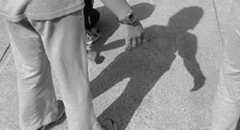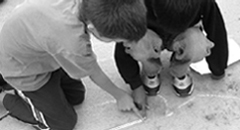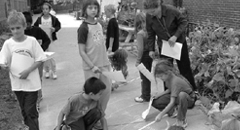
|

|

|
What do these features of learning look and feel like in the classroom? What actions are taken and what ideas are held by students, teachers, and others in learning groups? Here we offer some additional details about learning in groups.
- The members of learning groups include adults as well as children.
- Teachers identify learning goals for themselves (often about how children build knowledge) as well as for their students.
- Teachers share their learning with other teachers, parents, and children.
- Parents generate their own research questions.
- Rather than seeing themselves as the sole or primary sources of information, teachers encourage students to enlist the cognitive and emotional support of their peers.
- Documenting children's learning processes helps to make learning visible and shapes the learning that takes place.
- Individuals in learning groups are often encouraged to share and compare their work.
- Learning becomes more visible and new learning happens when teachers share children's work and words with them by, for example, putting quotations and samples of children's work on the walls.
- Documenting children's learning entails making decisions about the moments and experiences that are most meaningful to record and build upon.
- The act of documenting slows teachers down and changes their understanding of what went on in the classroom.
- Members of learning groups are engaged in the emotional and aesthetic as well as the intellectual dimensions of learning.
- Teachers look for topics of study that will stimulate passion and wonder and captivate the imagination so that adults and children want to learn more.
- In seeking to make the ordinary extraordinary, Reggio teachers pose questions such as: Do these materials generate unexpected transformations or strong aesthetic effects? Do they inspire passion or curiosity or joy? Will children and adults be motivated to create work of the highest quality?
- The aesthetic dimension can be found in three aspects of the learning environment: the set-up of space and choice of materials; the nature of the learning process; and the nature of ideas.
- The focus of learning in learning groups extends beyond the learning of individuals to create a collective body of knowledge.
- Children working in a small group are often responsible for sharing what they are learning with the rest of the class.
- Reggio teachers often ask, "What can you do to remember what you did so that you can communicate it to others?" This focus on sharing learning with the group also supports individual learning by asking children to consider their learning from another perspective.
- In schools or classrooms operating as a learning group, school work involves more than completing a series of discrete tasks; children and adults feel like they are contributing to a larger, more meaningful whole, one they can share in and communicate to others.
Other Aspects of Learning in Groups
[Home] [Site Map]